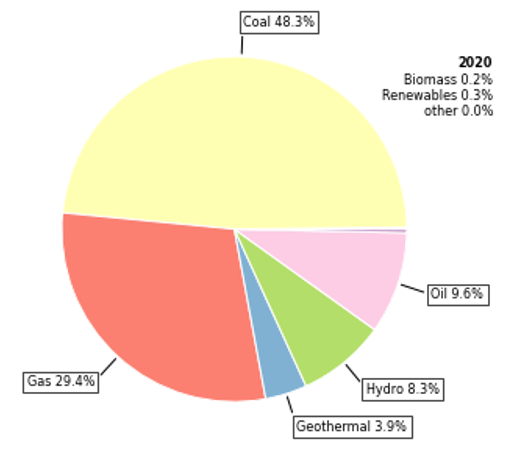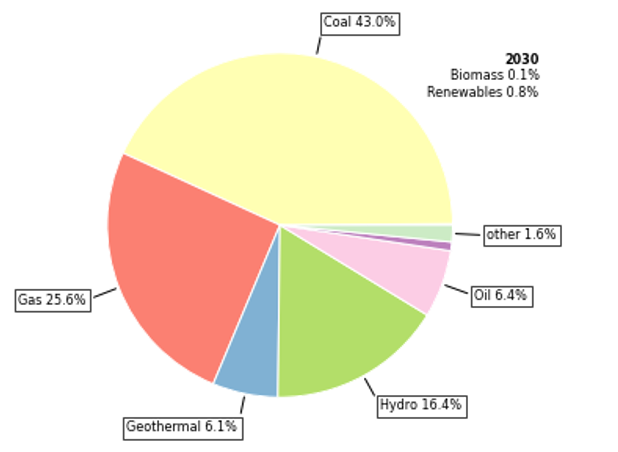Indonesia’s potential for geothermal energy production is one of (if not the) highest in the world. The government plans to increase the total installed capacity of geothermal power plants to 9,300 megawatts (MW) by 2035.1 This is very ambitious: Indonesia currently has just 2,443 MW of installed geothermal capacity, second only to the US (3,700 MW).2 This expansion would likely make the country the global leader in geothermal power.
Game-changing energy
Geothermal energy could be a game-changer for Indonesia because it helps fulfill several of the government’s goals:
- Extending universal electricity access. Electrification rates in Indonesia are still below 100%. A rapidly growing population, and unique geographic conditions, make this an even greater challenge.
- Reducing carbon emissions. Indonesia is one of the world’s biggest emitters, mostly because of deforestation and forest fires, but also due to fossil fuels used in energy consumption. The government aims to have 25% of the country’s electricity coming from renewable sources by 2030, the majority of which would be hydro.3
- Bolstering economic resilience. Using geothermal to replace existing fossil fuels would decrease dependency on imports, lowering vulnerability to fuel price fluctuations.
- Increasing reliable power sources. Geothermal power is a stable source of energy, making it ideal to replace existing coal facilities in the country without the need to invest in additional ancillary services that other renewables require.
FIGURE 1: Indonesia’s current electricity mix in 2020 vs expected in 20304


Geothermal’s challenges in Indonesia
Risky Business
Developing geothermal energy in Indonesia (and elsewhere) comes with high upfront costs (for surveying and drilling) and high risks that a company could invest a lot of capital in exploration but not find any viable sources. Consequently, it’s difficult for private companies to secure loans from private banks to build geothermal power plants. With funds from agencies such as the World Bank and the Asian Development Bank, the Indonesian government can help reduce this risk by partially bearing the cost of exploration, therefore incentivizing both local and private investors. Successful geothermal investments could foster more interest from the private sector and create a market for geothermal power in Indonesia.
Environmental Concerns
Most of Indonesia’s geothermal sources are located near or in forest areas, which is where the geothermal power plants would be built. While geothermal energy itself might not be harmful to the environment, building a plant requires infrastructure such as roads, which could have environmental and social consequences for endangered wildlife, freshwater supply, and cultural and religious values. It is important to consider these potential costs when evaluating project viability, especially in comparison to viable alternative energy types.
A solution to the climate-economic growth paradox
Indonesia is a middle-income country and a success story of growth and lifting people out of poverty. This required increased energy consumption, which has led to even more energy demand as people become richer.
When reliant on fossil fuels, energy consumption contributes to climate change. Climate change will affect all sectors of Indonesia’s economy, but agriculture will be the hardest hit, both in production and consumption, threatening food security, particularly for the rural poor. However, economic growth is one partial solution to supporting these vulnerable populations, as it:
- Provide people with more resources, especially energy, to protect themselves from climate change (ex: technology investments such as climate control, and better health care).
- Brings structural transformation, where typically people move out of climate-sensitive sectors such as agriculture to the manufacturing and services sectors, where their livelihoods are not heavily reliant on the climate.
However, growth requires and creates more energy consumption, which in some instances can lead to more emissions. Countries like Indonesia need growth to adapt to climate change, but this growth may exacerbate its effects if the energy comes from high-emitting fossil fuels. This is where renewable energy such as geothermal can be a game-changer and break the negative feedback cycle between growth and climate change. Geothermal energy has major potential to drive economic growth in line with low-carbon development.
Endnotes
- “Indonesia remains ambitious on its geothermal development targets set at adding 2,620 MW by 2030 with an estimated required investment of $10.4 billion,” Andrew Richter, Think Geoenergy, October 4, 2021.
- “ThinkGeoEnergy’s Top 10 Geothermal Countries 2020 – installed power generation capacity (MWe),” Andrew Richter, Think Geoenergy, January 7, 2021.
- “UPDATE 2-Indonesia targets greater solar capacity by 2030 under new plan,” Bernadette Christina & Fransiska Nangoy, Reuters, October 5, 2021; “Indonesian govt finalises new rules for renewable electricity,” Reuters, October 22, 2020.
- RUPTL 2021-2030.
